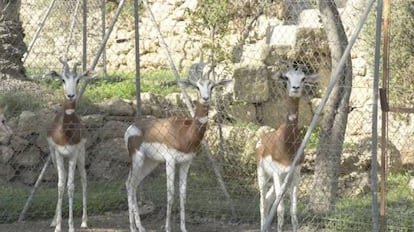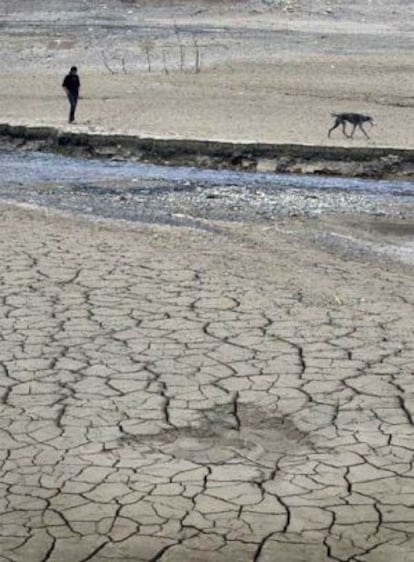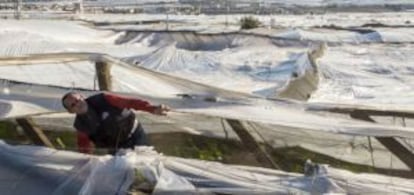The desertification of Almería
Land degradation is an increasingly growing threat in Europe’s driest region


In the heart of the city of Almería, gazelles from the Sahara run around at the foot of the Arab fortress known as the Alcazaba.
This alone should be a good indication of how similar the southern Spanish city’s climate is to that of Africa.
The first few antelopes arrived here in 1971 as part of a project conducted by the state-sponsored Spanish National Research Council (CSIC), and the population has since grown to over 400.
They talk a lot, but when I leave Almería and see the way they waste water elsewhere in Spain, it makes me cringe”
Lola Gómez, grower from El Ejido
This is now their home. And in the case of the mhorr gazelle – also known as the dama gazelle – it is their only home, as the wild population is now extinct in its native habitat.
“Almería is a unique place, it’s got the closest thing to the climate of their native home,” says Teresa Abaigar, a biologist at the breeding center. “In fact, when they arrived here, we made them a shelter but they never used it.”
Almería is the driest region in all of Europe, but there’s nothing new there – that has been the case for thousands of years.
The real cause for concern is how whole new areas are now succumbing to desertification.
“The desert is an ecosystem that’s thousands of years old, with a lot of diversity and interaction between species. But in a desertified area, everything is in vain; even the vegetation dies off,” says Juan Puigdefábregas, one of the world’s leading experts on desertification.
Vicente Andreu, director of the Desertification Research Center (CIDE) in Valencia, believes that people are not really aware of what such land degradation means.
“They think about dunes and camels, but it goes deeper than that,” he says. “It means loss of biological production due to human action, which prevents the sustainability of the ecosystem.”
Such desertification is underway in five places in Spain, covering one percent of the territory. But around 30 percent of land has already been degraded.
Desertification progresses in places where excessive watering takes place, such as the new olive groves in eastern Andalusia, the farming fields of La Mancha where the Júcar and several other rivers are drying up, and in the Ebro Valley.

It is also occurring on the great grazing fields that stretch from Salamanca to Huelva, where EU subsidies for cattle breeders have led to a surge in the size of herds.
But the area in most serious danger is by far the 30,000 hectares of land in and around El Ejido, in Almería – a sea of plastic greenhouses devoted entirely to growing fruit and vegetable crops for export to Europe.
The intensive agricultural activity here is depleting the aquifers and raising salt levels in the soil, bringing El Ejido ever closer to becoming the Spanish version of the Niger Delta in west Africa.
That was a textbook case. A long period of rains in the 1960s created a fertile cropland that attracted many immigrants to the delta. Aggressive agricultural techniques were introduced, and farmers racked up debts. Then came a terrible drought. Business floundered, but people couldn’t leave. It was the end of paradise.
Francisco Domingo Poveda, director of the Almería-based Arid Zone Experimental Station (Eeza), warns that “El Ejido could end up like that as well.” When, exactly, is unclear, but the risk is very real.
Growers in the area are aware of the threat. “How can we not be, if every year we see the climate changing and less and less rain coming down,” admits Lola Gómez, a 49-year-old farmer with a family business.
The people of El Ejido are sick and tired of being depicted as heartless businesspeople who are ruining the land and exploiting immigrants just to produce bland, flavorless tomatoes.
Desertification is underway in five places in Spain, covering one percent of the territory
Lola was three when her father set up his first plastic greenhouse, nearly half a century ago. She was 16 when he stopped flooding the earth and instead began using drip irrigation systems for his crops, back in 1981.
Lola represents the next generation, and has spent the last 14 years focusing on organic crops, combating plagues with other animal species and re-utilizing water in a closed circuit. She even uses coconut fibers left over by the auto industry as substrate for her seeds (car manufacturers use coconut shells to make dashboards – just one of the odd facts to be learned in El Ejido).
What’s certain, says Lola, is that if back in 1981 local growers used 230 cubic hectometers of water a year to irrigate 10,000 hectares, these days they use just 120 to water a surface area three times as big. People around here are obsessed with making the most out of each drop of precious water.

The trouble is, they’ve been digging for decades, going down as deep as 600 meters. Now, they trust that technology will save the more than 15,000 families and small businesses that make a living out of agriculture here. Their hopes are pinned on a new desalination plant at Campo de Dalías, which will soon be operational and, it is hoped, will contribute 20 percent of required water 15 years from now.
Lola is tired of the prejudices regarding their “sea of plastic.”
“They talk a lot, but when I leave Almería and see the way they waste water elsewhere in Spain, it makes me cringe. What we do with water here in Almería, you won’t see anywhere else in the world, because we know what it’s worth.”
“Yes, they’re very good about that, about using very little water,” says Puigdefábregas skeptically. “But that means that salt levels go up. When that happens, they switch to a different spot, and that is how the area becomes desertified. They say they use as little water as possible, but that could already be too much. And there’s also the problem of marine intrusion: when the water pressure below ground level goes down, the seawater comes in, and once that happens, there’s no solution.”
English version by Susana Urra.







































